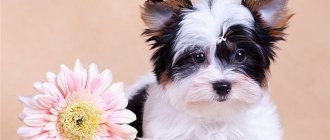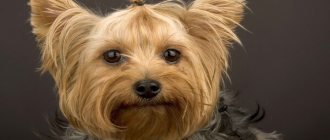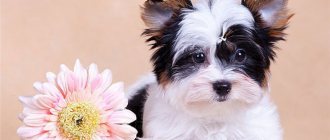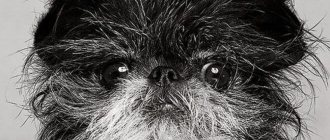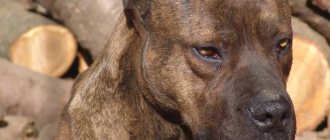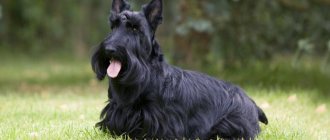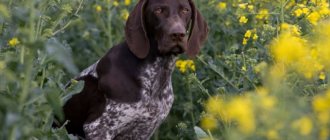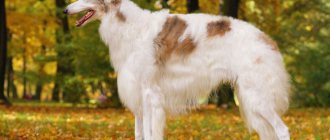May 28, 2018
9813
0
The Yorkshire Terrier is an adorable little dog that can melt your heart just by looking at you. Many new owners, having bought a Yorkie, believe that they have brought a calm and quiet friend into the house, but in reality everything turns out to be completely different. Despite its miniature appearance, the Yorkshire Terrier is a breed with a serious disposition and sometimes difficult character. Before getting a Yorkie, we recommend that you familiarize yourself with the behavioral characteristics of the animal.
Origin story
The breed was developed in the 18th century in England, in Yorkshire..
At that time, there was a law prohibiting the keeping of medium- and large-sized dogs by members of the lower strata of society, which made it necessary to breed small dogs capable of hunting and destroying rodents in mines and farms.
Yorkies did not stay in the role of hunters of mice and rats for long - these pretty animals were noticed by representatives of high society and the dogs left the mines and farms, moving to salons and boudoirs.
The appearance of the first Yorkshire terriers was significantly different from modern representatives of the breed, but as a result of painstaking selection work, breeders managed to obtain dogs with a more graceful appearance.
There is an opinion that when breeding Yorkies, Manchester Terriers, Maltese and Clydesdales and Paisleys, which do not exist today, were used..
In 1886, the English Kennel Club recognized Yorkshire Terriers as a separate breed, and in 1898 an official standard was adopted.
The first Yorkshire terrier appeared in Russia in 1971 - it was a gift to the ballerina Olga Lepeshinskaya, and in 1991 the first kennel in Russia was founded in Mytishchi.
Pet character
Yorkies are companion dogs, infinitely devoted to their owner, striving to accompany and support him everywhere and in everything.
Incredible attachment to the owner is the reason that these dogs absolutely cannot stand parting with him and experience psychological and physical suffering when left alone.
Representatives of this breed are famous for their energy, cheerful disposition and love of life; they love active games and walks.
Yorkies are good-natured and friendly dogs that do not show aggression.
At the same time, they are brave and fearless, so they will not hesitate to defend their owner or their territory, even if the enemy is larger than them.
A characteristic feature of Yorkshire terriers is their ability to empathize . Feeling that the owner is sad, the dog will try with all his might to cheer him up or simply lie down next to him, expressing support and readiness to help.
Pets accurately capture the mood of their household, which helps them find a common language with any family member.
Expert opinion
Kozhevin Semyon Kirillovich
Expert dog handler.
Of course, Yorkies are positive and friendly, but do not forget about the so-called Napoleon complex. These dogs are not aware of their own size and feel at least like shepherds or Rottweilers, often provoking and getting into fights with larger dogs. Also, representatives of this breed especially need socialization, otherwise you should not expect a healthy psyche and adequate behavior from the dog. In general, Yorkies are well suited for city dwellers and people leading an active lifestyle - these dogs do not require much space and like to spend a lot of time on the move.
Character
Dogs of this breed are very good-natured, cheerful, and clean. They love to play with their owner and will never refuse a walk outside. The Yorkshire Terrier, even with its small size, considers itself a protector of its owner, so it can growl at strangers. Other pet character traits:
- The desire for independence. If you do not indicate to the dog that he is the head of the family, he may determine this position for himself.
- High socialization. York is very friendly, so he easily finds a common language with other pets and gets along with them easily.
- Cheerfulness and friendliness. These are basic character traits, but if treated harshly they can bite.
Advantages and disadvantages
Yorkshire terriers are undoubtedly beautiful and charming, but it’s not just their appearance that has made this breed popular; Yorkies also have a lot of positive characteristics.:
- their small size makes them ideal pets for people living in small apartments or houses;
- These are ideal companions on any journey and trip, they tolerate the road well and quickly adapt to a new place;
- they are friendly, energetic and active, they love outdoor games and long walks;
- Yorkshire Terriers are loyal to their owner and love children;
- these dogs are smart, quick-witted and can make their own decisions after assessing the environment;
- they are easy to train.
In addition, Yorkies do not have an undercoat, which means they do not shed.
However, Yorkies are still not ideal and have the following disadvantages::
- they absolutely cannot stand loneliness;
- require labor-intensive and expensive care;
- have an imperfect digestive system and need a carefully selected and balanced diet;
- prone to allergic reactions.
Yorkies are also sensitive to high and low air temperatures - in summer pets must be protected from overheating, and in winter they must be dressed in warm clothes.
Read more about the pros and cons of Yorkshire Terriers here.
Yoricks are best friends and companions
The fashion for small dogs originated from celebrities. You can meet this charming animal not only among world stars, but also in residential areas of most cities. York is valued by many families for its energetic character and very kind disposition. Even being descended from hunting breeds does not prevent you from having them as pets. Terriers are considered the most loyal companions who follow their owner everywhere - on vacation, for a morning run or for a business meeting. A special feature of Yorkies is their high degree of adaptation to city life.
Color variations
The breed standard stipulates the following color:
- from the back of the head to the base of the tail, the coat is steel-gray, but not silver, without red, bronze or dark hairs;
- the coat on the chest and paws is a rich golden brown color, darker at the roots;
- the hair on the head is golden brown, on the ears it is reddish-yellow-brown.
Non-standard but popular color variations include :
- Russian salon - coat of red shades, from wheat to red;
- black - Yorkies are completely black, without tan or inclusions of other shades;
- goldust – coat color of various shades of gold;
- chocolate – color varies from milk chocolate to dark chocolate color;
- biro - a coat of three colors: chocolate brown, white and golden.
Separately, we should mention the Biewer Yorkshire Terriers, which have black and white hair on the body and black, white and gold on the head.
NOTE!
Biewer Yorkies are not a variety of Yorkshire terriers, but a separate breed.
Description of the breed
At the beginning of Yorkie breeding he was not so compact. The softness, color and length of the coat were also slightly different. Over time, painstaking selection brought out modern graceful and more elegant Yorkies. The animals were characterized by a high tail. Their ears are erect and their backs are straight. Even with its miniature size, the dwarf terrier has strong bones. In terms of proportions, the dog cannot be called fragile. There are several varieties of this breed:
- Mini Yorkie. Appear after mating a mini-male and a regular female. The weight of an adult pet does not exceed 1.8 kg.
- Biewer Yorkshire Terrier, or simply Biewer. This Tricolor Yorkie breed is not recognized by the FCI. It came from the mating of Maltese dogs and Yoricks.
- Baby face. They are very popular. The baby face has a short muzzle with large eyes, which is why the Yorkie dog takes on childlike features.
- Standard York. Characterized by the classic features of the breed, it has the usual size and weight.
- Muscovites apply for an electronic medical record
- Working pensioners have extended sick leave
- What documents do the bank need to defer loan payments?
Appearance
Yorick in modern conditions is more sophisticated compared to his ancestors. The breed is considered decorative. The animal's undercoat was replaced by luxurious fur that flows to the floor. According to the breed description, the weight of an adult pet is limited to 3 kilograms. Growth has no restrictions, but only if the body is proportional and meets all standards. On average, it is no more than 23 cm for a boy and 20 cm for a girl.
Standard
The Yorkshire Terrier has a very unusual appearance. It is reflected by the breed standard, which describes the main characteristics of the pet’s physique:
- The head is small, slightly flattened on top. The muzzle is of medium size, short with tight-fitting lips and not pronounced chewing muscles. The forehead is rounded, the transition is noticeable.
- The ears are erect and V-shaped. The ear cartilage is elastic, not too thick. The outside of the small ears is covered with not very long, richly colored hair.
- The tail is set high, and when the pet is in a good mood, it stands straight up. It stops before the age of 5 days.
- The limbs are thin, smooth, and have well-developed joints. The hocks and stifles are weakly expressed at an obtuse angle. The brushes are firmly assembled and round in shape.
- The eyes are not protruding, set at an average distance. The color is as dark as possible, brown. The animal's gaze is wary, intelligent, and lively.
- The body is square-shaped, compact, not long. The neck is practically hidden under the fur. The shoulders are strong, the withers are weakly expressed, the chest is oval, not very wide and deep. The belly is tucked up, the back line is short, and the back itself is strong.
Types of animals
The division of Yorkshire terriers into varieties is arbitrary and is not provided for in the official breed standard.
Based on weight, Yorkies are divided into:
- standard – 2-3.1 kg;
- mini – 1.4-2 kg;
- super-mini or micro – no more than 1.5 kg.
You can also distinguish baby-face Yorkies, which have a shorter muzzle, the length of which is equal to a third of the length of the skull.
As a rule, dogs that are too low weight have many health problems and a short life expectancy..
Distinctive features of Mini Yorkies
In general, they are considered a defect of the breed, for this reason they do not participate in exhibitions. A terrier is considered mini if it weighs no more than 1.8-2 kg. Such pets get sick more often than standard ones. They require a more delicate handling due to the high risk of injury. Even the fontanelle in mini-Yories closes much later. You should not get them if there are already large dogs or small children in the house, who could accidentally harm the pet. Other features:
- They are even more attached to their owner. Being without it for a long time can cause psychological trauma for pets.
- The temperament of this species is calmer, although capriciousness and stubbornness are noted.
- The cost of mini dogs is much higher compared to standard terriers.
- Animals eat little, but may not see enough in their food, so their diet must be carefully monitored.
Attitude towards children
Unlike other toy breeds, Yorkshire Terriers love children and get along well with them..
However, it is better not to have them for families with children under 5-6 years old, because kids can inadvertently harm small dogs by pushing, stepping on them or squeezing them too hard, but children of primary school age and older understand that this is not a toy, but a living creature.
Where can I buy
Purchasing a puppy from a kennel guarantees the purity of the breed. in this case, you can view the packages of documents of the animal and its parents. The breeder himself should inquire about future living conditions. This is a criterion that he cares about his charges. In Moscow you can buy a Yorkshire Terrier in the following kennels:
- "Urban Yorkies";
- RKF (Russian Cynological Federation);
- International Canine Union of Clubs;
- "Annlari."
How much does York cost?
The cost of the animal is determined depending on the purpose of the purchase. It will be slightly lower if documents for the pet are not required. York without a pedigree is also cheaper. Approximate prices for each case are shown in the table:
| Purchase terms | Price for Moscow, rubles | Price for St. Petersburg, rubles |
| With veterinary passport and brand | 30000 | 30000-35000 |
| With pedigree | 45000-50000 | 40000-50000 |
| No pedigree | 18000-20000 | 15000-20000 |
- 10 useful products for car enthusiasts
- How to properly treat coronavirus at home
- Pink salmon in the oven
Maintenance and care
Yorkshire Terriers are domestic dogs not suitable for kennel keeping..
They need to allocate a place in the house away from drafts and heating devices, placing a bed or house there.
Wool and bathing
Yorkies need to be bathed about 3 times a month; more frequent washing dries out the dog’s skin.
For washing, use a professional shampoo and conditioner that matches your pet's coat type..
To prevent the fur from becoming tangled, it must be combed daily. The dog needs to be cut approximately once every quarter. If this is a show animal, the haircut can only be hygienic; if not, then it all depends on the desire and imagination of the owner.
Ears and eyes
Once a week, it is necessary to examine the dog’s ears and clean them of wax using a cotton swab and special drops or lotions (shown in the photo).
If during the examination redness, inflammation or an unpleasant odor is detected, you should contact a veterinarian..
Yorkies' eyes require daily care - they need to be wiped with a cotton pad using a special lotion. Irregular care and increased lacrimation are the cause of the development of eczema.
Tooth and claw
After a complete change of teeth, you need to brush them every day with a special toothbrush and toothpaste.
Nails, if they do not grind down on their own, should be trimmed 2 times a month using a guillotine nail clipper and filed with a nail file to avoid delamination..
Yorkies also need timely vaccinations, deworming and treatment for fleas and ticks.
Health and major diseases
Due to the short muzzle, eye injuries and non-overgrowth of the fontanel, which increases the risk of head injuries, are not uncommon for Yorkies..
Also often found in Yorkshire terriers is distichiasis, a pathology characterized by the growth of additional eyelash rows, due to which the eyelashes curl and begin to grow inward, leading to corneal injuries, and a narrow tear duct and hair getting into the eyes are the causes of conjunctivitis.
To prevent hair from getting into the eyes, it must be collected in a ponytail or cut.
Teeth are also not a Yorkie's strong point . These dogs may have a violation of the change of teeth, and due to the lack of timely and regular cleaning, plaque and tartar form, leading to periodontal disease and tooth loss.
Among the pathologies of the musculoskeletal system, Perthes' disease is often diagnosed - destruction of the femoral head. The disease manifests itself at three months of age and leads to lameness.
In addition, breed diseases are :
- allergy;
- hypoglycemia;
- pancreatitis;
- dermatitis and other skin pathologies;
- alopecia;
- cataract and glaucoma;
- displacement of joints, dislocation of the kneecap, fractures;
- renal pathologies;
- pharyngeal spasms and difficulty breathing;
- hernias
Most diseases are caused by improper care of your pet.
Health problems
The lifespan of Yorkies is 14-16 years. During this time, dogs are characterized by good health and comparative problem-free behavior. Such statistics apply only to purebred animals that are examined for congenital diseases. Among the ailments often found in this breed are:
- ear diseases – occur due to hypothermia and owner’s oversight;
- inflammation of the mouth cavity, tartar - develop due to the special composition of saliva;
- slow change of teeth - molars grow against the backdrop of milk teeth that have not fallen out, as a result of which the correct bite deteriorates;
- indigestion - due to dental diseases and shortened intestines;
- fractures, ruptures and sprains of ligaments and tendons, dislocations - occur when falling from a height or unsuccessful jumps;
- necrosis of the femoral head, congenital dislocations, wedge-shaped vertebrae are genetic;
- umbilical hernia – congenital defect;
- ataxia is a hereditary disease manifested by weakness or complete lack of control of any muscle groups;
- obesity - often caused by the owner, who leaves the bowl full when leaving for work;
- hydrocephalus – is an accumulation of fluid in the cavity of the cranium.
Diet
Yorkshire Terriers require a balanced diet.
These can be natural products or ready-made industrial food; it is only important not to mix both types of food.
If we are talking about a natural diet, it is necessary to include a pet in the menu:
- boiled lean meat - rabbit, turkey, beef;
- boiled offal - heart, lungs, liver;
- cereals – rice, buckwheat or millet;
- lean sea fish;
- greens and vegetables;
- fermented milk products, cottage cheese.
Low-fat cheese and fruits can be given as treats.
Yorkies should never be given:
- beans and corn;
- pasta and bread;
- fat meat;
- sweets, smoked foods, pickles, marinades;
- tubular bones;
- cabbage, turnips, potatoes;
- citruses;
- grapes and raisins;
- onion;
- milk;
- freshwater and fatty fish;
- mushrooms;
- nuts.
With a natural diet, Yorkies need additional vitamins and minerals..
Having given preference to industrial feed, you need to purchase only premium, super premium or holistic feed.
The best feeds are:
- Acana;
- Orijen;
- Bozita;
- Monge;
- Royal Canin;
- Pro Plan;
- Mera Dog.
Dry food must contain at least 25% meat, and holistic food must contain at least 70%.
Also, the dog should always have access to clean water.
Education and training
Thanks to their high intelligence and quick wit, Yorkies are easy to train, but due to their stubbornness and independence, they can refuse to follow commands. Therefore, the owner must be patient and persistent, and exercise regularly.
You need to start training as early as possible and immediately show who is in charge, otherwise the dog will not obey and will try to take the place of the leader..
You should start by mastering simple commands - “place”, “toilet”, “come to me”.
Then you need to learn the commands “sit”, “walk”, “no” or “fu”, as well as “near” and “lie”. In addition, it is necessary to teach the dog to refuse food if it is given by strangers.
Training and education of a Yorkie should be based on the pet's play and interest, and should not be physically punished..
Number and change of teeth
Yorkies' teeth begin to grow 2 weeks after birth.
First, 2 canines appear on each jaw, then premolars and incisors - 12 on each jaw and by 1.5-2 months there should be 28 milk teeth.
If the puppy has an incomplete set of teeth or their number exceeds the norm, there may be problems with the bite or growth of the molars in the future.
The change of teeth begins at 3 months; at 6-8 months, a Yorkie should have 42 molars: 12 incisors, 4 canines, 16 premolars and 10 molars.
How to choose? Boy or girl?
It is best to purchase a Yorkshire Terrier puppy from a specialized nursery.
Before purchasing, you need to inspect the living conditions of the dogs and find out about the health of the parents of the future pet.
In a healthy puppy:
- clean, soft and shiny wool;
- there is no rash, redness or other damage to the skin;
- nose cold and wet, without discharge;
- scissor bite;
- paws are straight, movements are confident;
- no discharge from the eyes.
The puppy should be cheerful, active, and show interest in people..
When choosing between a bitch and a dog, you must remember that bitches are more affectionate and obedient and easier to train.
The only problem is estrus 2 times a year.
At this time, the pet’s character and taste preferences may change. Also, do not forget that it can leave marks on the floor and furniture.
Males are more freedom-loving, stubborn, and are more difficult to litter train. They tend to mark territory and become uncontrollable when they smell a bitch in heat.

